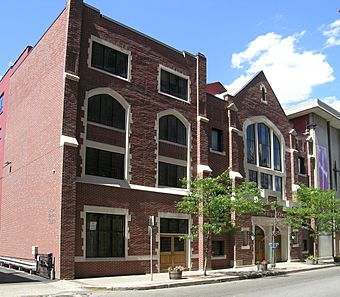Second Baptist Church (Detroit) facts for kids
|
Second Baptist Church Of Detroit
|
|
|
U.S. Historic district
Contributing property |
|
 |
|
| Location | 441 Monroe Street Detroit, Michigan |
|---|---|
| Built | 1914; 1926, 1968 (additions) |
| Architect | William E. N. Hunter |
| Architectural style | Gothic Revival, Brutalist |
| Part of | Greektown Historic District (ID82002902) |
| NRHP reference No. | 75000970 |
Quick facts for kids Significant dates |
|
| Added to NRHP | March 19, 1975 |
| Designated CP | May 06, 1982 |
The Second Baptist Church is a very important church located in Detroit, Michigan. You can find it in the Greektown area. It's special because it's the oldest African-American church in the Midwest part of the United States. This church was recognized as a Michigan State Historic Site in 1974 and added to the National Register of Historic Places in 1975, which means it's a place with a lot of history.
Contents
History of Second Baptist Church
The Second Baptist Church was started in March 1836. It was founded by 13 people who used to be slaves. They left their old church because they faced unfair treatment. Second Baptist became the seventh main church in Detroit.
Helping People Find Freedom
The church was very close to the Detroit River and the border with Canada. This made it a perfect spot to help people escape slavery. The church quickly became a "station" on the Underground Railroad. This was a secret network that helped enslaved people travel to freedom.
The church built a special room under its main area. Escaping slaves could hide there until they were ready to continue their journey. From its start until the end of the Civil War, the church helped about 5,000 people reach Canada. Church leaders also helped create groups in Canada that worked to end slavery.
Supporting Education and Rights
The Second Baptist Church did more than just help people escape. In 1839, it opened Detroit's first school for black children. This was a big step for education in the city.
The church also hosted important meetings. In 1843 and 1865, it held a "State Convention of Colored Citizens." At these meetings, people asked the Michigan government to allow black citizens to vote.
Many important people have connections to this church. Ralph Bunche, who later won the Nobel Peace Prize, was baptized here. The Second Baptist Church also helped start over 30 other African-American churches.
The Church Building
The main church building you see today was built in 1914. It has three floors. Before this, an older church building was destroyed by a fire. Later, more parts were added to the building in 1926 and 1968. These additions are on the sides of the original structure.
Older Sections of the Church
The parts built in 1914 and 1926 are made of brick. They have Gothic Revival style details, which means they look like old European churches with pointed arches and tall windows. These details are made of limestone.
The 1914 building has a rectangular shape with a pointed roof. The front of the church has a large, tall window with decorative wood. Below this window, there are two entrance doors. These doors are inside pointed arches and have a decorative wall above them.
Newer Sections of the Church
The addition built in 1968 is in the Brutalist style. This style uses strong, blocky shapes and often features concrete. This part of the church was designed by Nathan Johnson. It has four floors.
The second and third floors have long, horizontal windows that wrap around the building. The windows on the fourth floor are set into a pattern of concrete blocks. Below the windows on the second and third floors, there are large concrete panels. The flat roof of this section extends out a bit on all sides.
Current Status of the Church
Today, the Second Baptist Church is still an active and important place of worship. It is a member of two different Baptist groups: the Progressive National Baptist Convention and the American Baptist Churches in the USA.
Reverend Lawrence W. Rodgers is the Senior Pastor of the church. He is the 24th person to hold this important position at Second Baptist.
See also

